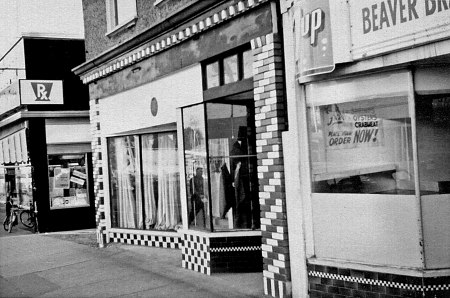VENUE

Black Spot, the
1960—1962
4345 Dunbar St.Established at the end of the beatnik era, the Black Spot featured poetry readings, chess playing, an all-black dress code, and spontaneous music making. John Le Marquand, who became part owner of the club in 1960 along with Ron Dobson, Tom Killiam, and Morris Jenkins, notes that, in the beginning, "music was provided by anyone who would get up from the crowd and bang on the upright piano." However, as the beats departed, the musical program of the club changed: A stage was built, and a group of regular musicians began frequenting the venue. With the arrival of a Victoria trio consisting of George Heller, Bob Kezierer, and Claire Lawrence, the Black Spot adopted "a serious jazz policy."
Although access to the club was permitted only to members, buying a card was inexpensive, and the venue was able to attract a large clientele from both Lord Byng High School and the University of British Columbia. The noise emanating from the Black Spot also attracted the attention of its neighbors, resulting in a "knock down drag out fight with city hall." The club was allowed to keep its license, but noise complaints would continue to haunt later incarnations of the Black Spot, namely the Flat Five.
Six months after Le Marquand joined the team at the Black Spot, they were bought out by the Contemporary Jazz Society, a group of fourteen musicians and club patrons. Le Marquand continued to run the venue under the new owners, and joined Society members in a subsequent venture involving a club called the Java Jazz.
The Java Jazz was opened in 1962 in the back of a restaurant at Locarno Beach. The owner, who wanted to concentrate on the food side of the enterprise, offered the Black Spot team the opportunity to provide music for the club in exchange for the door charge. As business at the Black Spot had been slowing down, they accepted. However, the venture was short-lived, as the restauranteur was unable to make enough money to pay his portion of the rent.
Although access to the club was permitted only to members, buying a card was inexpensive, and the venue was able to attract a large clientele from both Lord Byng High School and the University of British Columbia. The noise emanating from the Black Spot also attracted the attention of its neighbors, resulting in a "knock down drag out fight with city hall." The club was allowed to keep its license, but noise complaints would continue to haunt later incarnations of the Black Spot, namely the Flat Five.
Six months after Le Marquand joined the team at the Black Spot, they were bought out by the Contemporary Jazz Society, a group of fourteen musicians and club patrons. Le Marquand continued to run the venue under the new owners, and joined Society members in a subsequent venture involving a club called the Java Jazz.
The Java Jazz was opened in 1962 in the back of a restaurant at Locarno Beach. The owner, who wanted to concentrate on the food side of the enterprise, offered the Black Spot team the opportunity to provide music for the club in exchange for the door charge. As business at the Black Spot had been slowing down, they accepted. However, the venture was short-lived, as the restauranteur was unable to make enough money to pay his portion of the rent.
PHOTO GALLERY
Click on thumbnail for larger image








BIBLIOGRAPHY
Le Marquand, John. "Re: Black Spot Photos." Email to Kristin Fung. 14 Mar. 2008.FOR MORE INFO
See Terry ClarkeSee Blaine Wikjord
See Bill Fawcett
Black Spot Jazz Club (1960s) Facebook Group
(login required)








